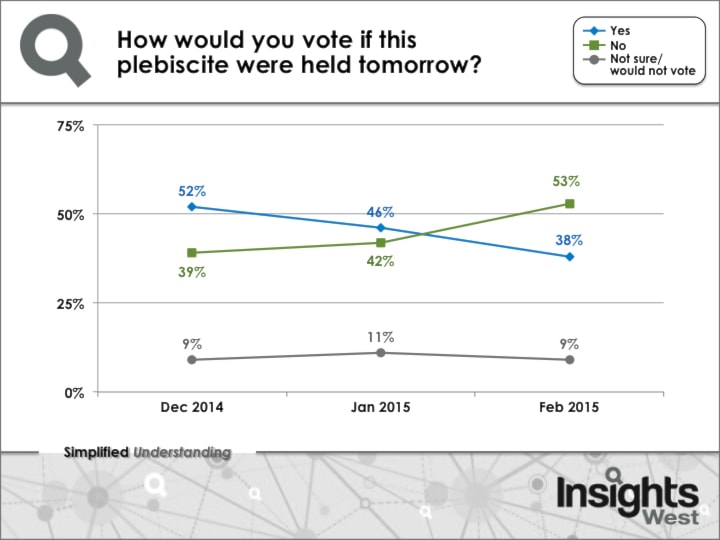A new poll now gives the No side a strong lead in the Metro Vancouver transit improvement referendum.
The latest Insights West online survey of 653 Metro residents found 53 per cent will "probably" or "definitely" vote against the 0.5 per cent Metro-only sales tax to fund various upgrades, while 38 per cent will likely vote in favour.
It's a reversal from earlier polls by the firm that had given the Yes side a four-point advantage as recently as January.
Insights West vice-president Mario Canseco said the strong gain for the No side appears to have come from drivers, middle-income earners and South of the Fraser area residents.
The latest survey was conducted Feb. 12-14, after the TransLink board decided to replace CEO Ian Jarvis but keep him on as an advisor until mid-2016 rather than pay severance.
Aimed at improving public confidence by installing a new CEO and a change of direction, the move has been widely criticized.
"As a short-term measure to instil confidence in the voters, it failed," Canseco said, noting just one in 10 voters say they trust TransLink to deliver new projects effectively. "It clearly hasn't helped the Yes side."
The new poll breaks down the results by sub-region for the first time.
It shows the strongest support is in Vancouver and Richmond, with 48 per cent Yes support to 45 per cent No.
The most opposition comes South of the Fraser, with 62 per cent likely to vote No and 31 per cent Yes.
It's a similar story on the North Shore, where 61 per cent are opposed and 27 per cent in favour.
Burnaby, the Tri-Cities and Maple Ridge-Pitt Meadows had 49 per cent likely No voters and 39 per cent in the Yes camp.
The level of undecided voters was six per cent in Vancouver, Richmond and South of the Fraser, and about 10 per cent elsewhere.
The margin of error is plus or minus four per cent, 19 times out of 20.
Canseco said the strong No vote South of the Fraser is surprising given the fact the area will be a main beneficiary of the upgrades.
New Surrey Mayor Linda Hepner's campaign promise to find an alternate way to build light rail if the referendum fails appears to have fed the No forces, he said.
"The fact there was a hint or a mention of a Plan B to get that light rail system going has a lot of people saying 'Why am I saying yes to a tax hike? There's no reason for me to vote and have a tax hike if the mayor has a solution that's not going to cost me money.'"
Canseco said the No campaign's use of Hepner's quotes "shows you how confusing this move has been."
He said opposition on the North Shore is more logical.
"You could argue the North Shore has a lot of drivers, a lot of people who don't see anything beneficial apart from the SeaBus."
Canseco said he doesn't see the Yes campaign as a lost cause, particularly as ballots won't arrive until the second half of March and voters could keep them around for several weeks before marking them.
But he said the mayors must find different messaging that works, particularly on drivers who are so far skeptical of the benefits and not yet swayed by warnings of crushing congestion in the years ahead under a status quo transit system.
Asked if the province could make changes to TransLink that would influence the outcome, Canseco said he doubts that will happen, given recent comments by the premier and transportation minister pushing responsibility firmly at the mayors.
"You start to see why they made this decision in the first place," Canseco said of the government's condition of a referendum for any new tax.
"If the Yes side were to win, it simplifies matters and makes them look like geniuses. If the No side wins, then it's the mayors' fault. They couldn't campaign well. They couldn't connect with their constituents."
